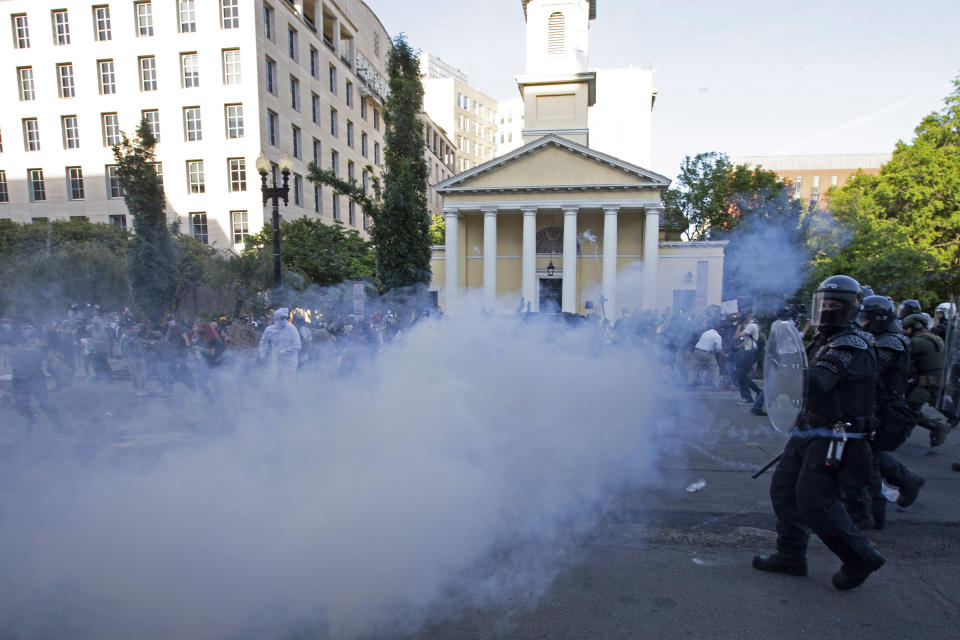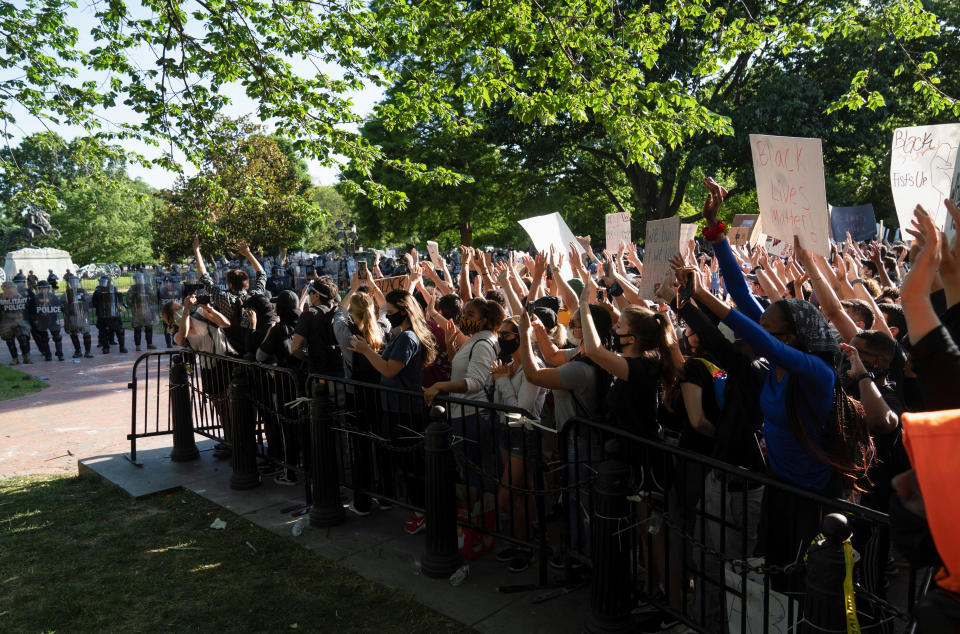Barr defends use of non-identified officers in D.C. as Democrats demand answers
WASHINGTON — Attorney General William Barr on Thursday defended the deployment of black-clad federal law enforcement officers who wear neither badges nor any other visible identification in response to protests in Washington, D.C.
Barr and Bureau of Prisons Director Michael Carvajal said at a Thursday press conference that the officers were from the Bureau of Prisons Special Operations Response Team (SORT).
“We normally operate within the confines of our institution, and we don’t need to identify ourselves. Most of our identification is institution-specific and probably wouldn’t mean a whole lot to people in D.C.,” Carvajal said.
“I probably should have done a better job of marking them nationally as the agency. Point is well taken. But I assure you that no one was specifically told in my knowledge not to identify themselves.”
On Thursday, Democratic Sens. Elizabeth Warren and Cory Booker, along with House Democratic Caucus Chair Hakeem Jeffries and Rep. Raja Krishnamoorthi, wrote to Barr about the “the use of federal security forces to oversee protests without specific agency identifiers or badge numbers.”
Krishnamoorthi is chairman of the House Oversight Subcommittee on Economic and Consumer Policy.
“The presence of these unidentifiable officials raises concerns that peaceful protesters might not be able to identify them as legitimate law enforcement officers, that law enforcement officers might not be able to identify each other, or that it might allow for other civilians that are ‘self-appointed assistants to police’ to falsely identify themselves as legitimate law enforcement officials,” their letter reads.

The letter also asks “why they were instructed not to disclose what agency they were from.”
Barr defended the decision to deploy SORT teams on the streets of D.C., saying that they are among the federal units best trained to deal with civil unrest. SORT teams are highly trained units that typically focus on handling emergency situations and potential violence in prisons, including quelling riots, thwarting escapes and conducting cell extractions. They use a variety of equipment including nonlethal munitions and firearms.
“In the Department of Justice we do not really have large numbers of units that are trained to deal with civil disturbances,” Barr said.
“Our Marshals response force is approximately 100 U.S. Marshals. And so, historically, when there have been emergencies where we have to respond with people who do have experience in these kinds of emergencies who are highly trained people, we use what are called SORT teams, response teams from the Bureau of Prisons.”
Barr did not apologize for the officers’ lack of recognizable marking or badges.
“In the federal system we don’t wear badges with our name. Agents don’t wear badges with their names and stuff like that, which many ... non-federal police agencies do,” Barr said. “And I could understand why some of these individuals simply wouldn’t want to talk to people about who they were if that in fact was the case.”
The Democrats’ letter requests that the government “make the necessary alterations to the uniforms of [Justice Department] personnel deployed to crowd response to provide for their identification in the event of misconduct,” and asks for a response by June 10.
The letter is the latest salvo from Democrats on Capitol Hill in their dispute with Barr over the use of force to combat protesters in the nation’s capital. Barr has become a lightning rod for criticism of the government’s handling of protests over the death of George Floyd in Minneapolis on May 25.
Democrats have called for a special prosecutor into Barr’s handling of law enforcement’s attack on protesters in Washington on Monday night. Democratic chairs of key committees in the House of Representatives have sent letters to the Secret Service seeking information about the events of that evening as well.

Barr took control of the federal government’s response that day, seeking to coordinate the patchwork of federal agencies operating on the streets of D.C. since the protests began. Monday’s move against protesters situated outside the White House came after three days of demonstrations that were accompanied by violence and looting in Washington and other cities.
Barr said his priority on Monday was to protect nonviolent protesters while bringing the city under control.
“If you use insufficient resources it’s dangerous for everybody,” he said Thursday. “Things could easily get out of control. ... The way to address it is to make sure the resources are there and people understand the resources are there to deal with that kind of violence.”
Barr defended his decision to order federal law enforcement officers to charge the protesters on Monday, saying it was necessary to extend the security perimeter around the White House and give law enforcement enough space to avoid injuries from thrown projectiles.
He said there were 115 injuries to law enforcement in D.C. this past weekend, including 22 hospitalizations. “Most of those were serious head injuries or concussions that required monitoring and treatment,” he said.
There have been reports of protesters throwing projectiles at officers before police charged the crowd on Monday, but most accounts from the scene indicated that the majority of people in the crowd were protesting peacefully.
Barr and the White House have said the protesters were given three warnings on Monday night. Those in the crowd said they heard no such warnings. In addition, law enforcement personnel is seen in multiple video accounts punching or shoving protesters and members of the press who did not appear to be doing anything provocative.
There have been conflicting reports about whether Barr’s decision to extend the security perimeter was to create space for the president to make the short, one-block walk from the White House to St. John’s Church. The church, which was built in 1816 and has hosted every president since then, was damaged by protesters last weekend.

Trump arrived at the church Monday for a much-criticized photo op in which he held up a Bible. Justice Department officials have said that the decision to extend the perimeter was made Sunday night or Monday morning, and when Barr arrived on the scene late Monday afternoon he was surprised it had not been done yet. He then ordered law enforcement to quickly extend the perimeter.
Law enforcement personnel charged into the crowd of protesters between the White House and St. John’s less roughly 20 minutes before Trump walked to the church. The law enforcement units deployed tear gas to disperse the demonstrators.
There were also military helicopters that hovered low to the ground over protesters to intimidate and disperse them on Monday night. That too has drawn questions about whether it was a legal and appropriate use of federal power, and both the commander of the D.C. National Guard and Secretary of Defense Mark Esper have said investigations will be launched into the matter.
Barr said the overwhelming show of force on Monday was responsible for calming the situation and preventing additional violence in the city.
“I think once that occurred it provided an environment where things could quiet down, and they did quiet down and hopefully they will stay quieted down,” Barr said.
Cover thumbnail photo: William Barr; members of the Federal Bureau of Prisons and other law enforcement personnel. (Photo illustration: Yahoo News; photos: AP, Brendan Smialowski/AFP via Getty Images)
_____
Read more:

